
Working As An Unskilled Worker In Korea: Some Hard Facts
The city I live in is an industrial city. With multitude of factories and companies around, inevitably we have many migrant workers. From time to time, you get to meet a few of them and talk. Last week, during one such talk I realized how the ‘Korean experience’ of these unskilled migrant workers is totally different than mine (ESL teacher).
In the past, I’ve met other migrant workers who were disillusioned with Korea and were having a difficult time. I think a lot of it had to do with the lack of information. So in this post, I want to mention a few things that you should know before you decide to come and work as an unskilled worker in Korea.
The Background
 The number of foreign workers in South Korea is on the rise. In the recent years, there has been an influx of immigrant workers in Korea. In fact, according to a report about 825,000 migrant workers are legally working in Korea.
The number of foreign workers in South Korea is on the rise. In the recent years, there has been an influx of immigrant workers in Korea. In fact, according to a report about 825,000 migrant workers are legally working in Korea.
A large portion of these workers are doing unskilled jobs. According to a government data released in 2015, 45 percent of the foreign workers are employed at factories, 31 percent working at construction sites and 12 percent hired in the service industry.
Only 12 percent foreigners working in South Korea are white-collar workers. Many in this group are working as English teachers or as professionals/executives in various multinational companies. The salary and working conditions for this group while not perfect, are comparable to global standards.
However, it’s a totally different story when it comes to the unskilled foreign workers. The unskilled workers typically work in labor-intensive sectors such as construction, manufacturing and agriculture.
A large number of foreign workers in South Korea are not native English-speakers. The largest nationalities are Chinese (mainly ethnic Koreans or Korean-Chinese), Vietnamese, Filipino, Bangladeshi, Pakistani and Thai. Believe it or not, this group is the new underclass in Korean society: unskilled migrant workers.
Compared to their white-collar counterparts, these unskilled migrant workers face discrimination, difficult working environment and verbal and physical abuse in the workplace.
Salary
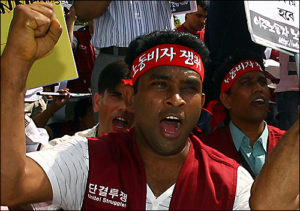 The unskilled migrant workers usually occupy many of the positions in the “3D” industry: jobs that are dirty, dangerous, and difficult. These are typical low-skilled jobs and consequently come with lower salaries. Thus, it’s a given that the unskilled migrant workers will receive lower wages due to the kind of the jobs they do.
The unskilled migrant workers usually occupy many of the positions in the “3D” industry: jobs that are dirty, dangerous, and difficult. These are typical low-skilled jobs and consequently come with lower salaries. Thus, it’s a given that the unskilled migrant workers will receive lower wages due to the kind of the jobs they do.
However, according to a recent study South Korea has the biggest wage gap between native and foreign-born workers among member countries of OECD. South Korea’s inequality in wages between locals and foreigners is about 55%, which is the highest among OECD countries.
The study also showed that more than 60 percent of the foreign laborers in Korea receive less than 2 million won ($1,700) in monthly wages, even though half of them worked more than 50 hours a week.
On average, expect to get less wages than your Korean counterparts. Depending on your employer you may have to work longer hours without overtime pay. There have been cases where the employers withheld the wages of the migrant workers.
In addition, discrepancies between the salary stated in the contract and what the migrant workers actually earn is not unheard of. In extreme cases, the employers make huge deductions from the salary for administrative costs of visa, immigration status, flight and accommodation.
Working Conditions
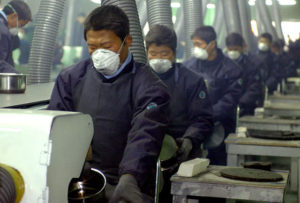 Migrant workers are typically required to work long hours and night shifts. They often operate heavy machinery or work with dangerous chemicals. Depending on where they work at and company regulations, they may receive little or no on-the-job training. Consequently, they are at greater risk of industrial accidents with inadequate medical treatment or compensation.
Migrant workers are typically required to work long hours and night shifts. They often operate heavy machinery or work with dangerous chemicals. Depending on where they work at and company regulations, they may receive little or no on-the-job training. Consequently, they are at greater risk of industrial accidents with inadequate medical treatment or compensation.
On many occasions, migrant workers fail to receive adequate medical treatment or compensation due to the language barrier, their unfamiliarity with their rights as workers or local laws, and their inability to access a lawyer.
Accommodations
Usually, the migrants workers have to share cramped lodgings with other workers. Some companies offer accommodations and food as part of the C.T.C. However, the company provided housing may be shared lodging or small studio style housing. Depending on your employer, you may have to incur the cost of accommodation and food.
Discrepancies Between The Contract And The Actual Work
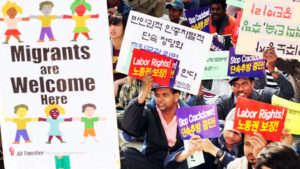 Upon arrival in South Korea, some migrant workers find that the job their employer offered to them in their home countries is different from the one awaiting them. Many contracts being offered are different from the actual work that they do once in South Korea. Often times, the salary is lower, hours are longer or work is more dangerous than what their employer had stipulated.
Upon arrival in South Korea, some migrant workers find that the job their employer offered to them in their home countries is different from the one awaiting them. Many contracts being offered are different from the actual work that they do once in South Korea. Often times, the salary is lower, hours are longer or work is more dangerous than what their employer had stipulated.
The Silver Lining
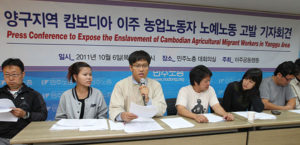 Although the things stated above are true and do happen, it’s not always the case. Public awareness about the struggles and hardships of migrant workers in South Korea is increasing. In recent years, Korean government have changed and implemented new laws regarding the human and labor rights of the migrant workers.
Although the things stated above are true and do happen, it’s not always the case. Public awareness about the struggles and hardships of migrant workers in South Korea is increasing. In recent years, Korean government have changed and implemented new laws regarding the human and labor rights of the migrant workers.
With the rise in social discourse over the migrant workers’ rights, the government is enforcing laws to protect migrant workers and to resolve the pay difference. Employers are legally bound to provide on-the-job training, industrial accident compensation and national health insurance for the migrant workers. The migrant workers are also covered by South Korea’s Minimum Wage Act.
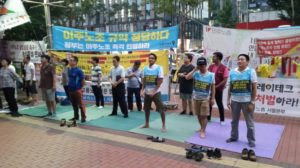 The Korean Ministry of Labor granted the Korean Migrants’ Trade Union (MTU) official legal registration, following a Supreme Court ruling on August 20th, 2015.
The Korean Ministry of Labor granted the Korean Migrants’ Trade Union (MTU) official legal registration, following a Supreme Court ruling on August 20th, 2015.
Change is in the air! There are high hopes for a better working environment and wages for unskilled migrant workers in the future.
